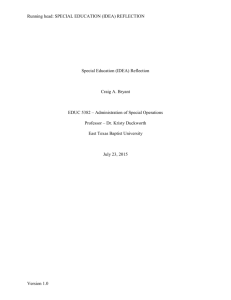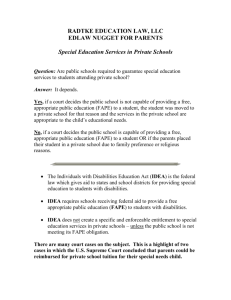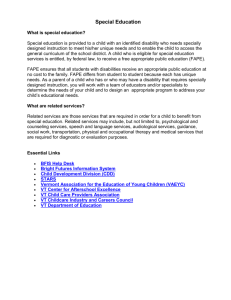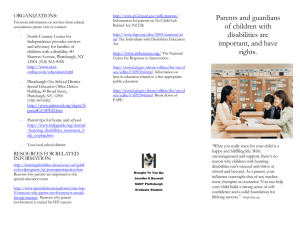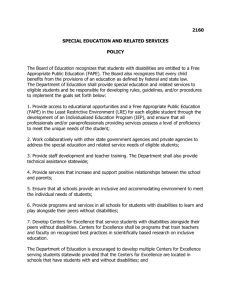a Copy - Rockdale County Public Schools
advertisement
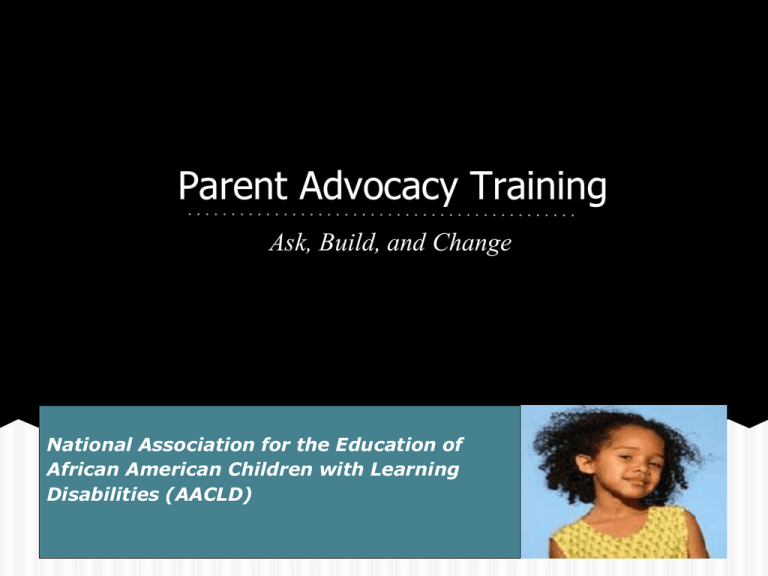
Parent Advocacy Training Ask, Build, and Change National Association for the Education of African American Children with Learning Disabilities (AACLD) National Association for the Education of African American Children with Learning Disabilities (AACLD) Individuals with Disabilities Education Act (IDEA) • What is it? IDEA is a law that ensures the appropriate special educational services are provided to all children with disabilities. It governs how states and local school districts provide early intervention, special education, and related services. IDEA (cont.) • What is its purpose? It provides federal funds to states for special education and related services so that they are able to make the human and educational resources available to the child to ensure provision of a free and appropriate public education (FAPE). Receipt of this funding requires states to abide by a number of principles under IDEA. IDEA (cont.) Major principles under IDEA: 1. States and school districts must make a free and appropriate public education (FAPE) available to all children with disabilities between the ages of 3 and 21. This includes using procedures to identify, locate, and evaluate students, regardless of the severity of their disability, to determine eligibility for special education. 2. Each child must have an Individualized Education Plan (IEP). Specific special education and related services provided to meet the child's needs. 3. Children with disabilities must be educated with children who are not disabled; States and school districts must provide procedural safeguards to children with disabilities and their parents. IDEA and the African American child Comments made by Congress: Greater efforts are needed to prevent the intensification of problems connected with mislabeling and high dropout rates among minority children with disabilities. More minority children continue to be served in special education than would be expected from the percentage of minority students in the general school population. African-American children are identified as having intellectual disabilities and emotional disturbance at rates greater than their White counterparts. Studies have found that schools with predominately white students and teacher have placed disproportionately high numbers of their minority students into special education. Working knowledge of key federal laws Public Law 94-142 Family Education Privacy Right Act (FEPRA) No Child Left Behind (NCLB) Elementary and Secondary Education Act (ESEA) Public Law 94-142 • What is it? This law guarantees that every child with a disability has a right to a free, appropriate education (FAPE) in every state and locality across the country. Public Law 94-142 has 4 purposes: 1. "to assure that all children with disabilities have available to the..a free appropriate public education which emphasizes special education and related services designed to meet their unique needs" 2. "to assure that the rights of children with disabilities and their parents...are protected" 3. "to assist States and localities to provide for the education of all children with disabilities" 4. "to assess and assure the effectiveness of efforts to educate all children with disabilities" FEPRA • What is it? It is a federal law that protects the privacy of student education records. It applies to all schools that receive funds under an applicable program of the U.S. Department of Education. Parents are given specific rights, which transfer to the student when he or she reaches 18 years of age or attends a school beyond the Specific Parent Rights: 1. Parents or students have the right to inspect and review the student's records maintained by the school. 2. Parents or students have the right to request that a school correct records they believe to be inaccurate or misleading. 3. Parents may request copies of records. Schools may or may not charge fees for this. Using FEPRA for Advocacy 1. To make informed decisions, parents must ensure they have ALL of their child's educational records. 2. Parents can access teachers assessment data, instructional information, and basically any information used to help their child achieve his/her goals as indicated on the IEP. No Child Left Behind Act (NCLB) • What is it? On January 8, 2002, President George W. Bush signed into law the No Child Left Behind Act of 2001 (NCLB). It incorporates a system of accountability, local control, parental involvement, and funding. NCLB demands that states build assessment systems that track the achievement of all students against a common set of high instructional standards and requires assessments for third- through eighth-grade students annually in reading and mathematics. Improvement among disadvantaged children must be demonstrated under the Adequate Yearly Progress (AYP) provisions of NCLB. Schools unable to demonstrate AYP will be provided with assistance and may be subject to possible corrective action. • What is the purpose? NCLB was created to help provide the best educational opportunities for our nation's children and to ensure that they have every opportunity to succeed regardless of their income, background, race or ability. It institutes a nationwide system of accountability and it places an emphasis on all children being able to read well by the end of third grade. Elementary and Secondary Education Act (ESEA) • What is it ? The U.S. Department of Education is allowing each State educational agency (SEA) to request flexibility on behalf of itself, its local educational agencies, and schools, in order to better focus on improving student learning and increasing the quality of instruction. • What is its purpose ? This provides educators and State and local leaders with opportunities to use alternative accountability and assessment measures to improve educational outcomes for all students, close achievement gaps, increase equity, and improve the quality of instruction, which is done through application of waivers submitted by the individual states. Section 504 of the Rehabilitation Act of 1973 • • What is it? Section 504 is a civil rights law designed to protect the civil and constitutional rights of persons with disabilities. Persons with disabilities are defined as individuals with a mental or physical impairment that substantially limits one or more major life activities. Major Life Activities under Section 504 Lifting/bending Caring for onself Speaking Performing manual tasks Breathing Seeing Learning Hearing Reading Eating Concentrating Sleeping Thinking Walking Communicating Standing Working • What is it's purpose? To protect individuals with disabilities from discrimination. As it pertains to education, regular or special education and related services should be designed to meet the individual needs of persons with disabilities that are equal to the needs of nondisabled persons. Section 504 Policies • • • • • The child must have a physical or mental impairment that substantially limits at least one major life activity. An evaluation from a variety of sources is required. A school district must conduct an evaluation of any individual who because of disability "needs or is believed to need" special education or related services. Tests and other evaluation materials must be validated for the specific purpose for which they are used. There must be a periodic reevaluation of students, consistent with the Education for the Handicapped Act. Review of Landmark Cases Brown vs. Board of Education PARC vs Commonwealth of Pennsylvania Mills vs. Board of Education Brown vs Board of Education History Before 1975, children with disabilities were excluded from public schools and those who weren't were either placed in grossly inadequate, segregated classrooms or in regular classrooms without adequate support. Impact There were 5 separate cases that were heard by the U.S. Supreme Court concerning the issue of segregation in public schools. The court ruled unanimously that "separate but equal" doctrine was unconstitutional, a violation of the Fourteenth Amendment. Special Education (SPED) The Basics What is Special Education? It is "specially designed instruction" at no cost to the parents, provided to meet the unique needs of the child with a disability. Educators are required to adapt, as appropriate to the needs of an eligible child, the content, methodology, or delivery of instruction. This includes instruction in the classroom, in the home, hospitals, and institutions. Corrective and Supportive Services Interpreting services Speech Therapy Psychological services Physical Therapy School nurse services Occupational Therapy Assistive Technology Counseling services Parent training ...and any other services that you can prove that child needs to access a free and appropriate public education. What is the purpose of SPED? • To address the unique needs of the child, resulting from the child's disability. • To ensure access of the child to the general curriculum, so that the child can meet the educational standards within the jurisdiction of the public agency that applies to all children. • Having equal access to the general curriculum means having the right to a Free and Appropriate Public Education (FAPE). Free and Appropriate Public Education (FAPE) Through special education and related services.... 1. Disabled students must be educated with non-disabled students, to the maximum extent appropriate. 2. Education services and treatment of the student must comply with the procedural requirement of IDEA and your state regulations. 3. Parents have protections in place to ensure their child receives appropriate education. Free and Appropriate Public Education (FAPE) 4. Parents protection included: * Participation rights: (1) You have the right to provide information for your child’s evaluation, (2) You have the right to be a member of any group that makes decisions regarding the educational placement of your child, and (3) You have the right to participate in meetings related to your child’s identification, evaluation, educational placement and the provision of FAPE. Notice rights: (1) You have the right to be informed in a timely manner of meetings related to your child’s identification, evaluation, educational placement and the provision of FAPE, (2) You have the right to be informed of any proposed changes in your child's identification, evaluation, educational placement and the provision of FAPE, Free and Appropriate Public Education (FAPE) (3) You have the right to be informed of any refusal by the school or AEA to make changes that you have requested in your child's identification, evaluation, educational placement, and the provision of FAPE, and (4) You have the right to receive notices in a manner and language you can understand. Consent rights: (1) You have the right to give or withhold your consent to an evaluation to determine if your child is eligible for special education services, (2) You have the right to give or withhold your consent to reevaluations of your child, (3) You have the right to give or withhold your consent for your child’s initial placement in special education, & (4) You have the right to withdraw your consent for continued special education and related services for your child. This must be done in writing. Free and Appropriate Public Education (FAPE) Your consent to an evaluation may be withdrawn before the evaluation is completed. Your consent to an initial placement may be withdrawn before the placement is made. Records rights: (1) You have the right to review educational records, (2) You have the right to ask that records be changed if you believe the records are incorrect or misleading, & (3) In many circumstances, you have the right to give your consent before records are disclosed to other agencies or persons. Independent educational evaluation right: You have the right to request an independent evaluation at no cost to you if you disagree with the evaluation done by the school. Through FAPE.... Your child is provided with an Individual Educational Program.... an IEP.

